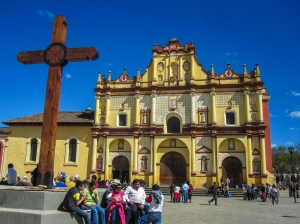A quick 12.5 hour overnight bus ride from Puerto Escondido and we had officially left the coast behind and arrived in San Cristóbal de las Casas in Chiapas. San Cristóbal is a stunning highland town that retains much of its colonial architecture. You are never at a loss to find places to eat or drink, the markets are incredible, and it’s all plunked among hills in highland Mexico which equals a literal breath of fresh air.
We’d gotten in the habit of, upon arriving to a city, booking our bus out. This habit is the cumulation of a number of factors, namely that the online booking system for the bus line we used the most in this part of the country does not accept international credit cards, travel agents (if you can find them) charge a premium, and we often ended up making the trip back to the bus station before our departure to buy a ticket, which is clearly a waste of time. The trouble with this is that it means making a blind call about how long to stay in a city. For San Cristóbal, we decided two nights, as we’d heard great things, and this was basically the maximum amount of time we could spend here while remaining on track.
I’m happy we didn’t sell ourselves short. The town seems like the kind of town where everything should be jumbled into place, radiating out from the main cathedral, but it’s not. The city is easy to navigate and is built on as close to a grid system as you’re going to get here. The main cathedral dominates the main plaza, and artisan markets – the best we’ve seen, by far – spring up next to two churches a few blocks away. Real de Guadalupe has a large pedestrian section and is crowded with eateries, shops, and bars. The streets are all ridiculously charming, and simply wandering around put me in a fantastic mood. The hills surrounding, a couple with churches perched on top, are less daunting than they appear to climb – despite the altitude – and offer outstanding views of the town and the hills and the surrounds.
The markets were amazing. It seemed to be a quiet market day when we were there, as many of the stalls weren’t occupied and the crowds were thin. Nevertheless, the array of goods available was truly outstanding. Unlike many a Mexican market, it was clear to see exactly where most of the products were coming from, as the stall-keeper was often creating more as they sat and waited for approaching customers. The prices were significantly lower than what we’d encountered elsewhere, so much so that it was almost impossible to barter; the value of the goods already exceeded what they were asking – in North American terms at least.
We got into a discussion during one of the evenings, on a rooftop, over wine. There is a huge amount of money tied up, for each of these vendors, in inventory. As they sit and create more goods while minding the market, this is only exacerbated. If nothing was created, at all, it would probably take a year to sell all of the completed work sitting in that market. This isn’t an ideal business model, of course. The solution to this isn’t easy to come up with – do you sell to shops in town, form a co-op, try to figure out how to export? There are a number of established shops in San Cristóbal selling artisans’ work as well, from boutiques to co-operatives, at a scale of different price points, all higher than in the market. Is this better or worse or the artists themselves? For the community? I bought something from one stall, minded by a young boy. He asked for 60 pesos, I offered 50 and he said yes. He then stared at the 50 peso note as if it were the largest amount of money he’d seen in a while. I don’t know how long 50 pesos would last a family, how much wool they could buy with that. I don’t know what it really means to them. We’re going through about 500 pesos a day, each, so it seems like a nominal amount. But the cost of living there, even compared to much of Mexico, is so much lower, that these amounts really make a difference. I’ve got a Bachelor of Commerce degree in my back pocket somewhere, and have become increasingly interested in micro finance and international development, at least in theory. But when you actually look at a situation, and try to start thinking about how it might be improved, it becomes fraught with difficulty. Who are we, for one, to decide if it needs to be improved in the first place? Our western view of efficiency and effectiveness does not and should not translate to many countries in the world. Yet surely, there are talented and hardworking people, who are struggling to get by, who need not struggle, if only the whole operation were to be rearranged a little bit. And like this, we talked, in circles, until the wine was gone.
![The Wander World [Travel Blog]](https://thewanderworld.files.wordpress.com/2012/10/cropped-waderworldheader1.jpg)

